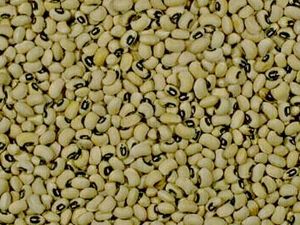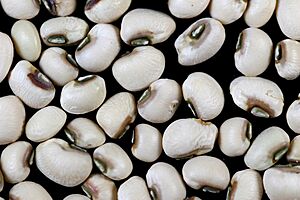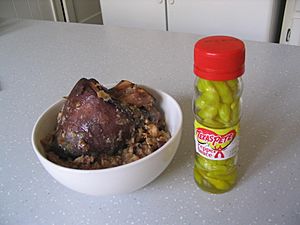Black-eyed pea facts for kids
The black-eyed pea, also known as the black-eyed bean, is a type of bean that people eat. It's a subspecies of the cowpea. These beans likely first grew in West Africa, but today they are grown all over the world. Black-eyed peas are a good source of nutrition, containing calcium, folate, protein, and fiber. They are also low in calories.
Quick facts for kids Black-eyed pea |
|
|---|---|
 |
|
| Scientific classification | |
| Kingdom: | |
| (unranked): | |
| (unranked): | |
| (unranked): | |
| Order: | |
| Family: | |
| Genus: | |
| Species: | |
| Subspecies: |
V. u. subsp. unguiculata
|
| Trinomial name | |
| Vigna unguiculata subsp. unguiculata (L.) Walp.
|
|
Contents
History of Black-Eyed Peas
Black-eyed peas were first grown by people in West Africa. From there, they spread to many countries in Asia. They arrived in the Southern United States in the 1600s. By the 1700s, they were widely grown in Florida and the Carolinas. Later, they became very popular in Texas too.
Today, black-eyed peas are still a key ingredient in soul food and other dishes in the Southern U.S. A famous scientist named George Washington Carver encouraged farmers to plant them. He knew that black-eyed peas, as a type of legume, help add good things like nitrogen back into the soil. This makes the soil healthier for other plants.
Growing Black-Eyed Peas
Black-eyed peas love warm weather. You should plant their seeds only after the danger of frost has passed. The soil needs to be warm enough, or the seeds might rot. These plants can handle dry conditions very well. So, you don't need to water them too much.
Black-eyed peas usually don't have many problems with pests or diseases. However, tiny worms called Root-knot nematodes can sometimes be an issue. Farmers often move their crops around (called "crop rotation") to help prevent these worms. Since black-eyed peas add nitrogen to the soil, you don't need to add much nitrogen fertilizer after they start growing.
The flowers of black-eyed pea plants make a lot of nectar. This nectar attracts many different pollinators, like bees. Because of this, farmers must be careful when using insecticides. They need to make sure they don't harm the helpful insects.
Black-Eyed Peas for Good Luck
New Year's Tradition in the Southern U.S.
In the Southern United States, many people eat black-eyed peas on New Year's Day. This tradition is thought to bring good luck and money in the new year. A common dish is called Hoppin' John. It's a traditional soul food meal.
Black-eyed peas are usually cooked with a pork product. This could be bacon, ham bones, or hog jowls. They are also cooked with diced onion. People often serve them with hot chili sauce or pepper-flavored vinegar. The meal often includes collard, turnip, or mustard greens, and ham.
Each part of the meal has a special meaning:
- The peas swell when cooked, symbolizing more money or good fortune.
- The greens represent paper money.
- Pork represents moving forward in life. This is because pigs push forward when they look for food.
- Cornbread is also often eaten with this meal. It represents gold.
There are a few stories about how this tradition started. One popular story goes back to the American Civil War. During this time, Union soldiers sometimes took food from Confederate areas. It's said that they left black-eyed peas and salted pork behind. They thought these foods were only for animals. Southerners felt lucky to have these supplies left to help them survive. So, black-eyed peas became a symbol of good luck. Another tradition says that black-eyed peas became a symbol of freedom for African-Americans. Many were officially freed on New Year's Day after the Civil War.
Black-Eyed Peas Around the World
Black-eyed peas are enjoyed in many different ways across the globe.
Africa and the Middle East
- In Egypt, black-eyed peas are called lobia. They are cooked with onions, garlic, meat, and tomato juice. This is served with rice.
- In Jordan, Lebanon, and Syria, green black-eyed beans are cooked with onions, garlic, tomatoes, and olive oil.
- In West Africa and the Caribbean, a dish called akara is popular. It's made from mashed black-eyed peas mixed with salt, onions, or peppers. This mixture is then fried.
Asia and the Pacific
- In Indonesia, black-eyed peas are called kacang tunggak. They are used in spicy curry dishes like sambal goreng.
- In North India, they are called lobia or rongi. They are cooked like daal and served with rice.
- In Maharashtra, India, they are called chawli and made into a curry.
- In Karnataka, India, they are used in a popular curry called huli.
- In Tamil Nadu, India, they are called karamani. They are often boiled and made into a salad-like dish called sundal.
- In Pakistan, they are called lobia.
- In Vietnam, black-eyed peas are used in a sweet dessert. It's called chè đậu trắng. This dessert has black-eyed peas, sticky rice, and coconut milk.
Europe
- In Cyprus, Greece, and Turkey, black-eyed peas are eaten in salads. They are mixed with vegetables, oil, salt, and lemon.
- In Portugal, black-eyed peas are served with boiled cod fish and potatoes. They are also used in salads and with tuna.
The Americas
- North America
- "Hoppin' John" is a traditional dish in the Southern United States. It's made with black-eyed peas, rice, and pork.
- Texas caviar is another dish from the American South. It uses black-eyed peas marinated in a vinaigrette dressing with chopped garlic. It's served cold.
- South America
- In Brazil, especially in the city of Salvador, black-eyed peas are used in a traditional street food called akara. The beans are peeled, mashed, and then deep-fried in palm oil. Acarajé is often served with other fillings like vatapá and hot sauce.
- In northern Colombia, they are used to make a fried snack called buñuelo. The beans are soaked, peeled, and then ground. Eggs are added, and the mix is fried. It's a healthy breakfast food.
- In Guyana and Trinidad and Tobago, black-eyed peas are popular beans cooked with rice. On New Year's Eve, families cook a special dish called cook-up rice. This dish has rice, black-eyed peas, other peas, and different meats. It's cooked in coconut milk. Eating cook-up rice is believed to bring good luck in the New Year.
Images for kids
-
Lobia curry, a black-eyed peas dish from India.
See also
 In Spanish: Alubia carilla para niños
In Spanish: Alubia carilla para niños







